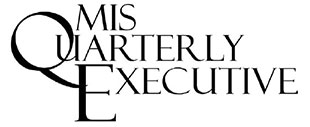Home > Journals > AIS Journals > MISQE

Information for Authors
The key criterion for publication in MIS Quarterly Executive is whether a paper provides new insights for Information Systems (IS) and business professionals engaged in IS decision-making.
Who Can Submit?
Anyone may submit an original article to be considered for publication in MIS Quarterly Executive provided he or she owns the copyright to the work being submitted or is authorized by the copyright owner or owners to submit the article. Authors are the initial owners of the copyrights to their works (an exception in the non-academic world to this might exist if the authors have, as a condition of employment, agreed to transfer copyright to their employer).
Submission Checklist
As part of the submission process, authors are required to check their manuscript's compliance with the guidelines below. Submissions may be returned to authors that do not adhere to these guidelines.
- The paper is formatted according to the MISQE formatting guidelines.
- The manuscript has not been published by, nor is under review at, another journal or as a book or book chapter.
- If the manuscript has been presented at a conference or published in a conference proceeding, this should be noted in the acknowledgements.
- The manuscript does not exceed 7,500 words.
- The manuscript is accompanied by an Addendum. The template for the Addendum can be found here.
- The names of the authors are listed on the first page only.
- The comment section in the submission form nominates at least one senior editor and two reviewers.
- Any necessary legal permission for publication has been obtained from the case organization.
- The authors allow MISQE to edit accepted manuscripts prior to publication.
- Manuscripts are submitted electronically via ManuscriptCentral by clicking here.
Nominating Editors and Reviewers
Authors should select the Senior Editor (SE) they wish to handle their paper and nominate a suitable backup. Note that the Editor-in-Chief may also can play the role of a Senior Editor in this process. Authors may also nominate possible reviewers, usually, but not always, selected from among the Editorial Board. If you choose to nominate someone who is not on the Editorial Board, please provide his or her e-mail address.
The nominees for Senior Editor and reviewers must have no conflict of interest with any of the authors of the paper being submitted. A conflict of interest includes, but is not limited to, situations where the nominee is any of the following:
- An author's student or former student.
- An author's academic advisor or former advisor.
- Someone who has co-authored with an author during the past five years.
- Someone located at the same institution as an author at the time of the paper's submission.
About the Uniqueness of the MISQE Review Process
Unlike the typical review process of academic journals, MIS Quarterly Executive authors will rarely engage in a long, multi-round, incremental process. While MIS Quarterly Executive reviews are developmental and seek to tangibly improve the paper, they typically strive for fast convergence to a publishable contribution. All papers are quickly screened by the Editor-in-Chief and sent to Senior Editors only when there is the potential for rapid progress. Given the value of timeliness in practice-oriented research, lengthy review process are not be the norm. MIS Quarterly Executive copy edits papers to improve readability and fit with the unique style of the journal.
The review process is as follows:
- Every submission will be screened for review readiness by the Editor-in-Chief and, if assigned, by the Senior Editor (SE).
- After passing the screening by the Editor-in-Chief and the Senior Editor, the submission will go to at least (but generally, no more than) two members of the Editorial Board who will serve as reviewers. They, in turn, can seek outside persons to be additional reviewers, but we expect this option to be used very rarely.
- The review process is typically single-blind.
- Authors can expect one document, from the Senior Editor, summarizing the consensus of the review team based on a meeting of the review panel. This is in contrast to a typical review packet from academic journals where authors receive separate reviews from each panel member. Such consensus-based reviews are, in our experience, easier to understand and faster to implement.
Review Criteria
In reviewing a submission, we consider the extent to which it:
- Provides insight (deeper understanding), rather than just description or just prescription, for both CIO and researchers in the field
- Offers timely, actionable and clear recommendations to the thoughtful CIO or current and future IS leaders
- Deals with management and use of Information Systems
- Is based on rigorous research
- Has the potential to influence practice
- Provides added value from our academic perspectives
- Is clearly written in an engaging style
Authors are encouraged to read recent editorials that offer further guidance:
- Junglas, Iris (2024) "About the Uniqueness of MIS Quarterly Executive Articles," MIS Quarterly Executive: Vol. 23: Iss. 4, Article 1. Available at: https://aisel.aisnet.org/cgi/cview.cgi/misqe/vol23/iss4/1
- Junglas, Iris (2024) "Pathways to Writing MIS Quarterly Executive Articles," MIS Quarterly Executive: Vol. 23: Iss. 1, Article 1. Available at: https://aisel.aisnet.org/cgi/cview.cgi/misqe/vol23/iss1/1
- Junglas, Iris (2023) "Guidance for Research Articles Submitted to MIS Quarterly Executive – Where Research Shapes and is Shaped by Practice," MIS Quarterly Executive: Vol. 22: Iss. 2, Article 1. Available at: https://aisel.aisnet.org/cgi/cview.cgi/misqe/vol22/iss2/1
- Piccoli, Gabriele (2019) "Editors’ Comments," MIS Quarterly Executive: Vol. 18: Iss. 1, Article 1. Available at: https://aisel.aisnet.org/misqe/vol18/iss1/1
- Piccoli, Gabriele (2019) "Editor's Comments," MIS Quarterly Executive: Vol. 18: Iss. 2, Article 1. Available at: https://aisel.aisnet.org/misqe/vol18/iss2/1
- Piccoli, Gabriele (2019) "Editors’ Comments," MIS Quarterly Executive: Vol. 18: Iss. 3, Article 1. Available at: https://aisel.aisnet.org/misqe/vol18/iss3/1
- Piccoli, Gabriele (2020) "Editors’ Comments," MIS Quarterly Executive: Vol. 19: Iss. 1, Article 1. Available at: https://aisel.aisnet.org/misqe/vol19/iss1/1
Along with:

